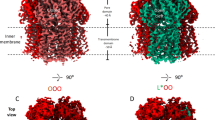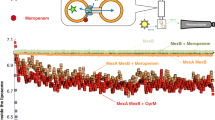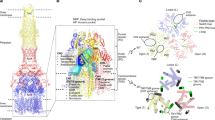Abstract
AcrB is a major multidrug exporter in Escherichia coli. It cooperates with a membrane fusion protein, AcrA, and an outer membrane channel, TolC. We have determined the crystal structure of AcrB at 3.5 Å resolution. Three AcrB protomers are organized as a homotrimer in the shape of a jellyfish. Each protomer is composed of a transmembrane region 50 Å thick and a 70 Å protruding headpiece. The top of the headpiece opens like a funnel, where TolC might directly dock into AcrB. A pore formed by three α-helices connects the funnel with a central cavity located at the bottom of the headpiece. The cavity has three vestibules at the side of the headpiece which lead into the periplasm. In the transmembrane region, each protomer has twelve transmembrane α-helices. The structure implies that substrates translocated from the cell interior through the transmembrane region and from the periplasm through the vestibules are collected in the central cavity and then actively transported through the pore into the TolC tunnel.
This is a preview of subscription content, access via your institution
Access options
Subscribe to this journal
Receive 51 print issues and online access
$199.00 per year
only $3.90 per issue
Buy this article
- Purchase on Springer Link
- Instant access to full article PDF
Prices may be subject to local taxes which are calculated during checkout





Similar content being viewed by others
References
Okusu, H., Ma, D. & Nikaido, H. AcrAB efflux pump plays a major role in the antibiotic resistance phenotype of Escherichia coli multiple-antibiotic-resistance (Mar) mutants. J. Bacteriol. 178, 306–308 (1996)
Ma, D., Cook, D. N., Hearst, J. E. & Nikaido, H. Efflux pumps and drug resistance in Gram-negative bacteria. Trends Microbiol. 2, 489–493 (1994)
Paulsen, I. T., Nguyen, L., Sliwinski, M. K., Rabus, R. & Saier, M. H. Microbial genome analyses: comparative transport capabilities in eighteen prokaryotes. J. Mol. Biol. 301, 75–100 (2000)
Sulavik, M. C. et al. Antibiotic susceptibility profiles of Escherichia coli strains lacking multidrug efflux pump genes. Antimicrob. Agents Chemother. 45, 1126–1136 (2001)
Tseng, T.-T. et al. The RND permease superfamily: An ancient, ubiquitous and diverse family that includes human disease and development proteins. J. Mol. Microbiol. Biotechnol. 1, 107–125 (1999)
Dinh, T., Paulsen, I. T. & Saier, M. H. Jr A family of extracytoplasmic proteins that allow transport of large molecules across the outer membrane of Gram-negative bacteria. J. Bacteriol. 176, 3825–3831 (1994)
Paulsen, I. T., Park, J. H., Choi, P. S. & Saier, M. H. A family of Gram negative bacterial outer membrane factors that function in the export of proteins, carbohydrates, drugs, and heavy metals. FEMS Microbiol. Lett. 156, 1–8 (1997)
Nikaido, H. How do exported proteins and antibiotics bypass the periplasm in Gram-negative bacterial cells? Trends Microbiol. 8, 481–483 (2000)
Zguruskaya, H. I. & Nikaido, H. Bypassing the periplasm: Reconstitution of the AcrAB multidrug efflux pump of Escherichia coli. Proc. Natl Acad. Sci. USA 96, 7190–7195 (1999)
Nikaido, H. & Zgurskaya, H. I. AcrAB and related multidrug efflux pumps of Escherichia coli. J. Mol. Microb. Biotechnol. 3, 215–218 (2001)
Thanassi, D. G., Cheng, L. W. & Nikaido, H. Active efflux of bile salts by Escherichia coli. J. Bacteriol. 179, 2512–2518 (1997)
Fujihira, E., Tamura, N. & Yamaguchi, A. Membrane topology of a multidrug efflux transporter, AcrB, in Escherichia coli. J. Biochem. 131, 145–151 (2002)
Zgurskaya, H. I. & Nikaido, H. AcrA is a highly asymmetric protein capable of spanning the periplasm. J. Mol. Biol. 285, 409–420 (1999)
Avila-Sakar, A. J. et al. Lipid-layer crystallization and preliminary three-dimensional structural analysis of AcrA, the periplasmic component of a bacterial multidrug efflux pump. J. Struct. Biol. 136, 81–88 (2001)
Koronakis, V., Shaff, A., Koronakis, E., Luisi, B. & Hughes, C. Crystal structure of the bacterial membrane protein TolC central to multidrug efflux and protein export. Nature 405, 914–919 (2000)
Poole, K. Multidrug efflux pumps and antimicrobial resistance in Pseudomonas aeruginosa and related organisms. J. Mol. Microbiol. Biotechnol. 3, 255–264 (2001)
Davis, J. P., Chen, F. W. & Ioannou, Y. A. Transmembrane molecular pump activity of Niemann-Pick C1 protein. Science 290, 2295–2298 (2000)
Doyle, D. A. et al. The structure of the potassium channel: molecular basis of K+ conduction and selectivity. Science 280, 69–77 (1998)
Toyoshima, T., Nakasako, M., Nomura, H. & Ogawa, H. Crystal structure of the calcium pump of sarcoplasmic reticulum at 2.6 Å resolution. Nature 405, 647–655 (2000)
Chang, G. & Roth, C. B. Structure of MsbA from E. coli: A homolog of the multidrug resistance ATP binding cassette (ABC) transporters. Science 293, 1793–1800 (2001)
Locher, K. P., Lee, A. T. & Rees, D. C. The E. coli BtuCD structure: A framework for ABC transporter architecture and mechanism. Science 296, 1091–1098 (2002)
Williams, K. A. Three-dimensional structure of the ion-coupled transport protein NhaA. Nature 403, 112–115 (2000)
Zhuang, J. et al. Two-dimensional crystallization of Escherichia coli lactose permease. J. Struct. Biol. 125, 63–75 (1999)
Yin, C.-C. et al. The quaternary molecular architecture of TetA, a secondary tetracycline transporter from Escherichia coli. Mol. Microbiol. 38, 482–492 (2000)
Heymann, J. A. W. et al. Projection structure and molecular architecture of OxlT, a bacterial membrane transporter. EMBO J. 20, 4408–4413 (2001)
Wang, B. C. Resolution of phase ambiguity in macromolecular crystallography. Methods Enzymol. 115, 90–112 (1985)
Ramakrishnan, C. & Ramachandran, G. N. Stereochemical criteria for polypeptide and protein chain conformations. II. Allowed conformations for a pair of peptide units. Biophys. J. 5, 909–933 (1965)
Guan, L. & Nakae, T. Identification of essential charged residues in transmembrane segments of the multidrug transporter MexB of Pseudomonas aeruginosa. J. Bacteriol. 183, 1734–1739 (2001)
Holm, L. & Sander, C. Mapping the protein universe. Science 273, 595–602 (1996)
Rowsell, S. et al. Crystal structure of carboxypeptidase G2, a bacterial enzyme with applications in cancer therapy. Structure 5, 337–347 (1997)
Srikumar, R., Li, X. Z. & Poole, K. Inner membrane efflux components are responsible for beta-lactam specificity of multidrug efflux pumps in Pseudomonas aeruginosa. J. Bacteriol. 179, 7875–7881 (1997)
Mazzariol, A., Cornaglia, G. & Nikaido, H. Contributions of the AmpC beta-lactamase and the AcrAB multidrug efflux system in intrinsic resistance of Escherichia coli K-12 to beta-lactams. Antimicrob. Agents Chemother. 44, 1387–1390 (2000)
Nikaido, H., Basina, M., Nguyen, V. Y. & Rosenberg, E. Y. Multidrug efflux pump AcrAB of Salmonella typhimurium excretes only those β-lactam antibiotics containing lipophilic side chains. J. Bacteriol. 180, 4686–4692 (1998)
Otwinowski, Z. & Minor, W. Processing of X-ray diffraction data collected in oscillation mode. Methods Enzymol. 276, 307–325 (1997)
Terwilliger, T. C. & Berendzen, J. Automated structure solution for MIR and MAD. Acta Crystallogr. D 55, 849–861 (1999)
Otwinowski, Z. MLPHARE, CCP4 Proc. 80 (Daresbury Laboratory, Warrington, UK, 1991).
Collaborative Computational Project No. 4. The CCP4 suite: programs for protein crystallography. Acta Crystallogr. D 50, 760–763 (1994)
Terwilliger, T. C. Maximum-likelihood density modification. Acta Crystallogr. D 56, 965–972 (2000)
Terwilliger, T. C. Reciprocal-space solvent flattening. Acta Crystallogr. D 55, 1863–1871 (1999)
Jones, T. A., Zou, J.-Y., Cowan, S. W. & Kjeldgaard, M. Improved methods for binding protein models in electron density maps and the location of errors in these models. Acta Crystallogr. A 47, 110–119 (1991)
Brünger, A. T. et al. Crystallography & NMR system: A new software suite for macromolecular structure determination. Acta Crystallogr. D 54, 905–921 (1998)
Laskowski, R. A., MacArthur, M. W., Moss, D. S. & Thornton, J. M. PROCHECK: a program to check the stereochemistry of protein structures. J. Appl. Crystallogr. 26, 283–291 (1993)
Kraulis, P. J. MOLSCRIPT: a program to produce both detailed and schematic plots of protein structures. J. Appl. Crystallogr. 24, 946–950 (1991)
Merritt, E. A. & Bacon, D. J. Raster3D: photorealistic molecular graphics. Methods Enzymol. 277, 505–524 (1997)
Nicholls, A., Sharp, K. A. & Honig, B. Protein folding and association: insights from the interfacial and thermodynamic properties of hydrocarbons. Proteins Struct. Funct. Genet. 11, 281–296 (1991)
Acknowledgements
We thank T. Tsukihara for advice on all stages of our X-ray crystallographic analysis and critical reading of this manuscript, and M. Yoshida, H. Nikaido and E. Bibi for critical reading and discussions. We are also grateful to A. Nakagawa, M. Kusunoki and G. Kurisu for help in the diffraction data collection and computation. We thank D. Goodhew-Davison for English correction. This work was supported by Grants-in-Aid from the Ministry of Education, Culture, Sports, Science and Technology of Japan. This work was done with the approval of the Joint Research Committee of Institute for Protein Research, Osaka University.
Author information
Authors and Affiliations
Corresponding author
Ethics declarations
Competing interests
The authors declare that they have no competing financial interests.
Supplementary information
Supplementary Information
Supplementary Information (PDF 36 kb)
Rights and permissions
About this article
Cite this article
Murakami, S., Nakashima, R., Yamashita, E. et al. Crystal structure of bacterial multidrug efflux transporter AcrB. Nature 419, 587–593 (2002). https://doi.org/10.1038/nature01050
Received:
Accepted:
Issue Date:
DOI: https://doi.org/10.1038/nature01050
This article is cited by
-
Molecular mechanisms of antibiotic resistance revisited
Nature Reviews Microbiology (2023)
-
A role for the periplasmic adaptor protein AcrA in vetting substrate access to the RND efflux transporter AcrB
Scientific Reports (2022)
-
Pyridylpiperazine-based allosteric inhibitors of RND-type multidrug efflux pumps
Nature Communications (2022)
-
Allosteric drug transport mechanism of multidrug transporter AcrB
Nature Communications (2021)
-
Structure and function relationship of OqxB efflux pump from Klebsiella pneumoniae
Nature Communications (2021)
Comments
By submitting a comment you agree to abide by our Terms and Community Guidelines. If you find something abusive or that does not comply with our terms or guidelines please flag it as inappropriate.



